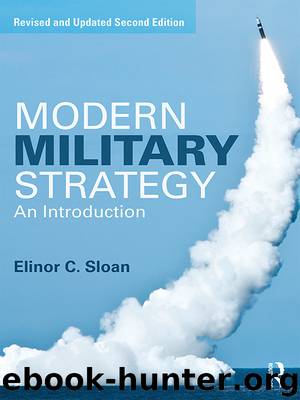Modern Military Strategy by Elinor C Sloan

Author:Elinor C Sloan
Language: eng
Format: epub
Publisher: Taylor and Francis
See: US Army, US Army and Marine Corps Counterinsurgency Field Manual (Chicago, IL: University of Chicago Press, 2007).
Perhaps the most useful strategic direction for operational-level activities is found in the manual’s summary of successful counterinsurgency practices which advises the occupying power to, among other things, focus on the population, its needs and its security; establish and expand secure areas; and secure host nation borders. Indeed, ‘secure the population’ has been identified by Petraeus as the central lesson of counterinsurgency.48 The doctrine later elaborates that counterinsurgency efforts should begin by controlling key areas and that security and influence should then spread out from secured areas. But considering its importance, this ‘oil spot’ strategy, which was advised by counterinsurgency theorists from Galula to Thompson to Krepinevich, receives surprisingly little attention. The latter two theorists stressed especially the importance of first securing the populous urban areas, an approach that was adopted in practice when it came to implementing the doctrine’s tenets in Iraq.
Despite FM 3–24’s predominantly classical counterinsurgency approach, the manual does touch on elements familiar from Hammes’ and Kilcullen’s strategic thought. ‘Today’s operational environment’, it notes, ‘includes a new kind of insurgency, one that seeks to impose revolutionary change worldwide … Defeating such enemies requires a global, strategic response [that] addresses the array of linked resources and conflicts that sustain these movements.’49 Yet the manual is short on what measures might be taken to effect such ‘disaggregation’. It includes an extensive discussion of tools to map an insurgent organization’s social network, noting that ‘such knowledge helps commanders understand what the network looks like, how it is connected, and how best to defeat it’, such as whether one should target enemy forces or enemy leaders.50 But, as with Kilcullen’s strategic thought, there are no further details on how, in this globalized, interconnected, real-time world, it is actually possible to sever links and isolate insurgents. This may be by design. The counterinsurgency manual agrees that networked organizations are difficult to destroy, but goes on to argue networks in any case have a limited ability to attain strategic success because they cannot easily muster and focus power. Meanwhile, commanders on the ground have expressed the view that thinking of the enemy as a network has had the effect of underemphasizing the critical and enduring importance of geography and controlling key terrain as a first step in spreading stability outward – perhaps a case of classical theory trumping the new-wave thinking of the information age.
A key author behind the production of FM 3–24 was Lieutenant-Colonel (retired) John Nagl, a strategic theorist in his own right. In his 2002 book Learning to Eat Soup with a Knife, Nagl argued the better performance of the British military in implementing a counterinsurgency strategy in Malaya in the 1950s as compared to the US military in Vietnam was due to differing organizational cultures. The British army was a learning institution, he determined, while the American army was not, and this led to different performances in terms of absorbing and applying the lessons of counterinsurgency.
Download
This site does not store any files on its server. We only index and link to content provided by other sites. Please contact the content providers to delete copyright contents if any and email us, we'll remove relevant links or contents immediately.
| Africa | Americas |
| Arctic & Antarctica | Asia |
| Australia & Oceania | Europe |
| Middle East | Russia |
| United States | World |
| Ancient Civilizations | Military |
| Historical Study & Educational Resources |
1805 by Richard Woodman(851)
Labyrinth of Ice by Buddy Levy(651)
RMS Titanic by Peter Davies-Garner(615)
A Game of Birds and Wolves by Simon Parkin(526)
1812: The Navy's War by George C. Daughan(517)
Rogue Warrior by Richard Marcinko(510)
Life by Tim Flannery(510)
Naval Warfare, 1815-1914 (Warfare and History) by Lawrence Sondhaus(445)
Sontag, Sherry - Blind Man's Bluff by Sontag Sherry(445)
The Rise And Fall of British Naval Mastery by Paul Kennedy(444)
American Naval History by Craig L. Symonds(422)
Tracing Your Merchant Navy Ancestors by Simon Wills(422)
Warship 2019 by John Jordan(418)
The Supercarriers: The Forrestal and Kitty Hawk Classes by Andrew Faltum(399)
Roosevelt's Navy by James Tertius De Kay(379)
The Imperial Cruise by James Bradley(370)
The Imperial Cruise: A Secret History of Empire and War by James Bradley(368)
Men-of-War by Patrick O'Brian(366)
Modern Military Strategy by Elinor C Sloan(353)
